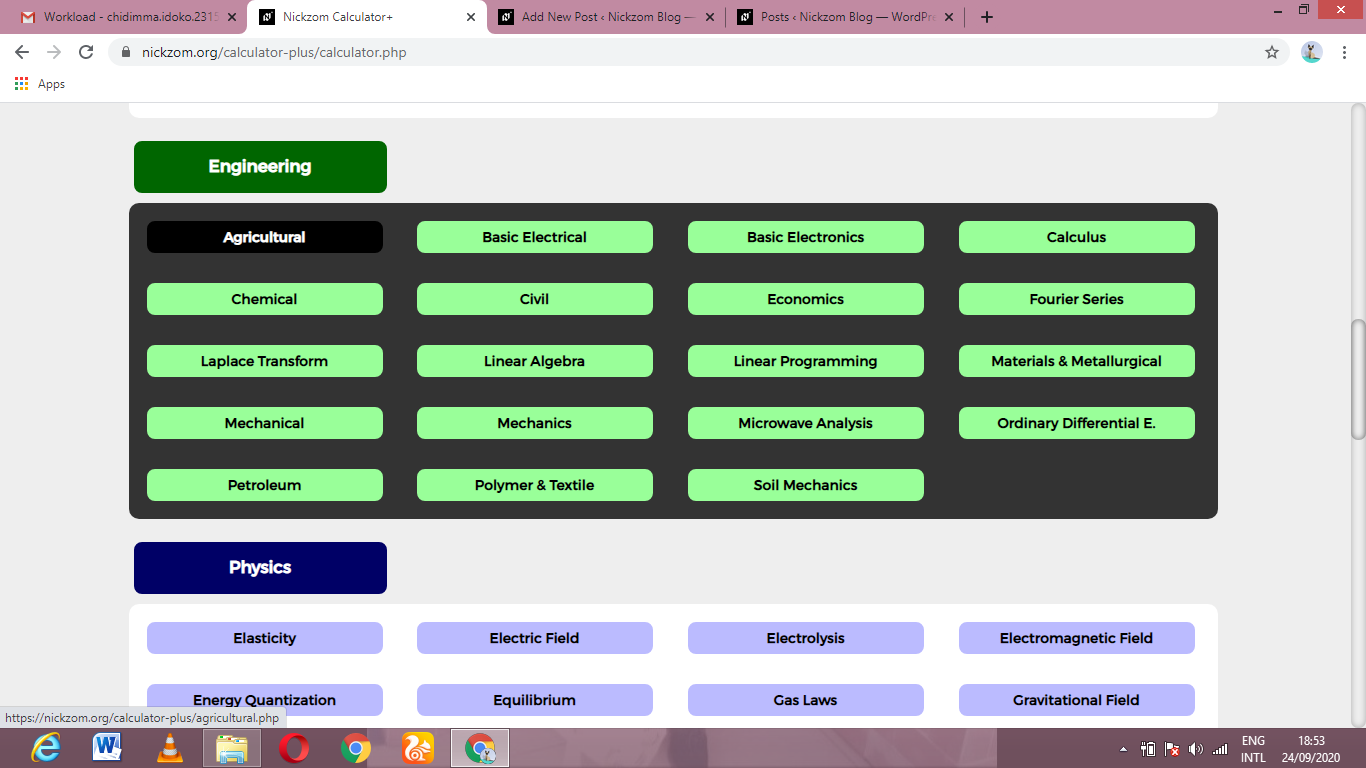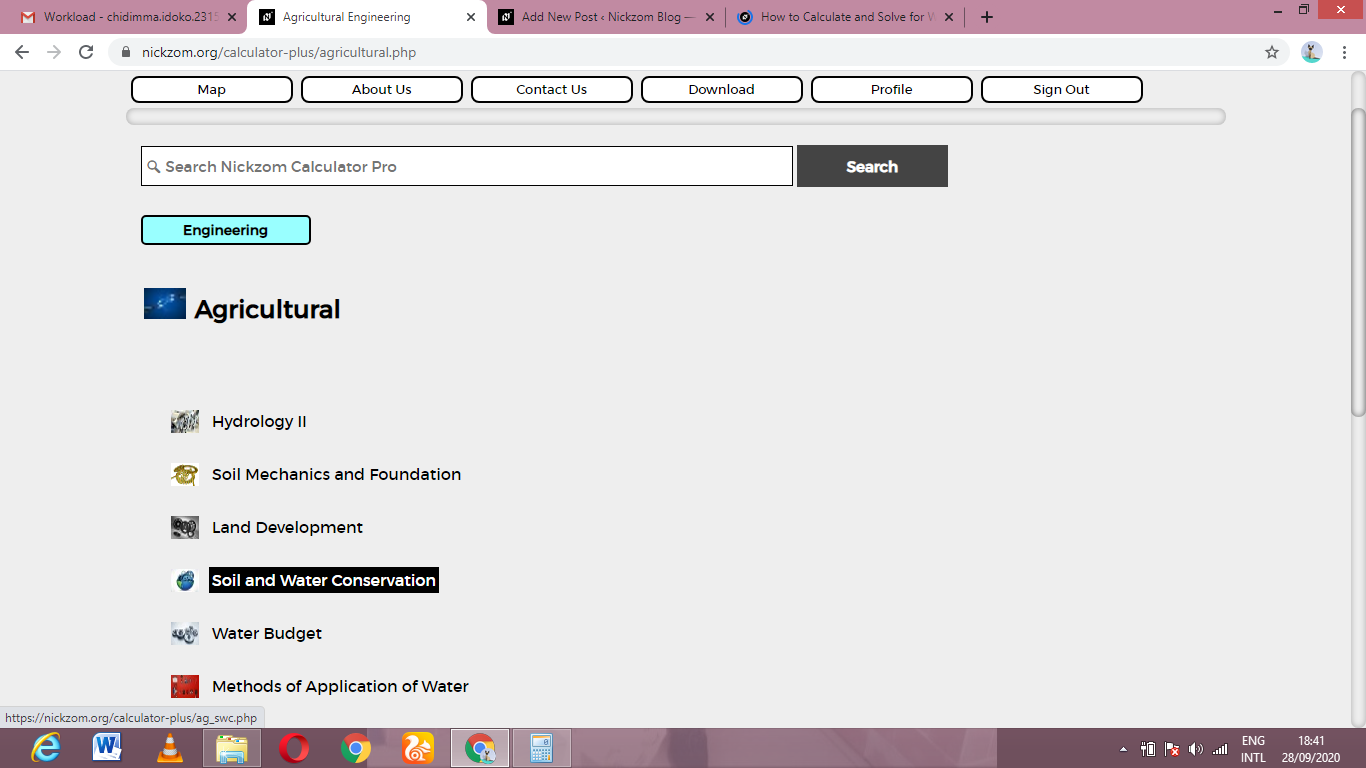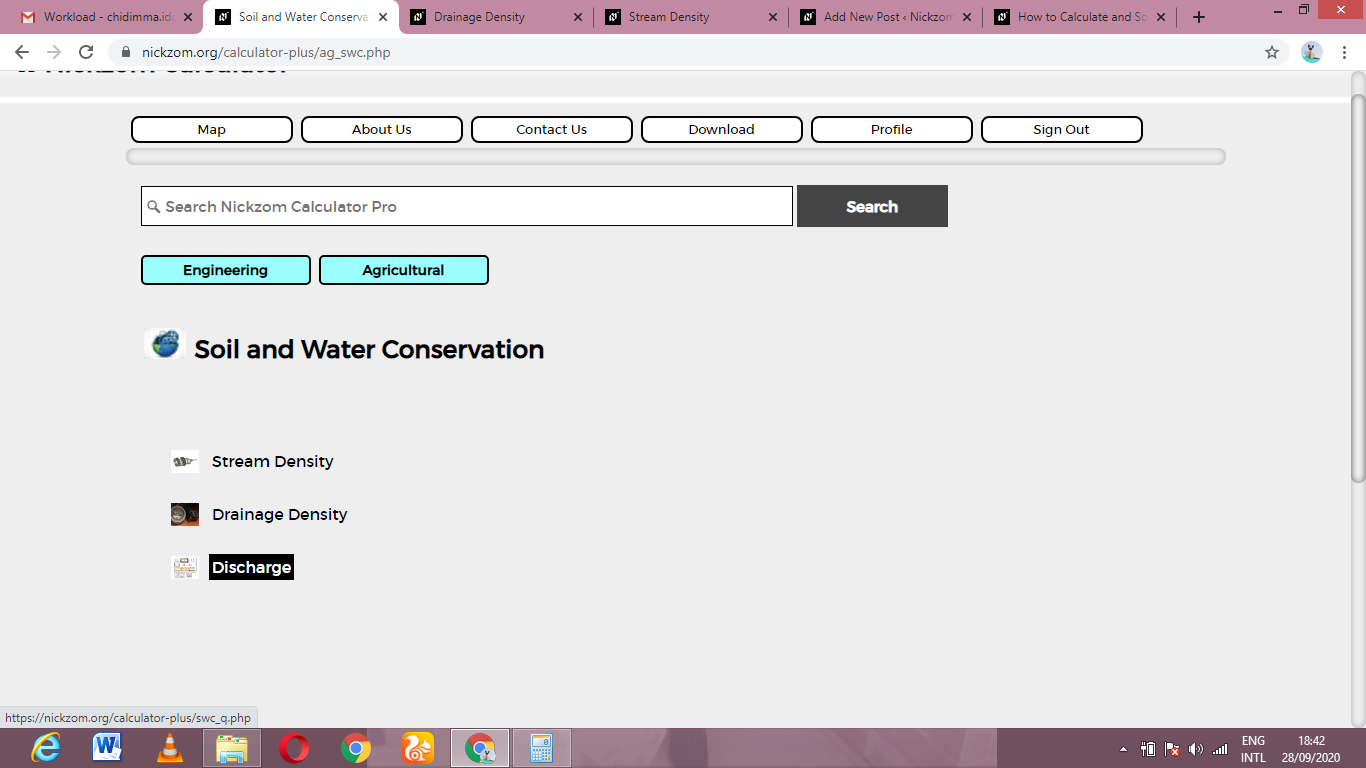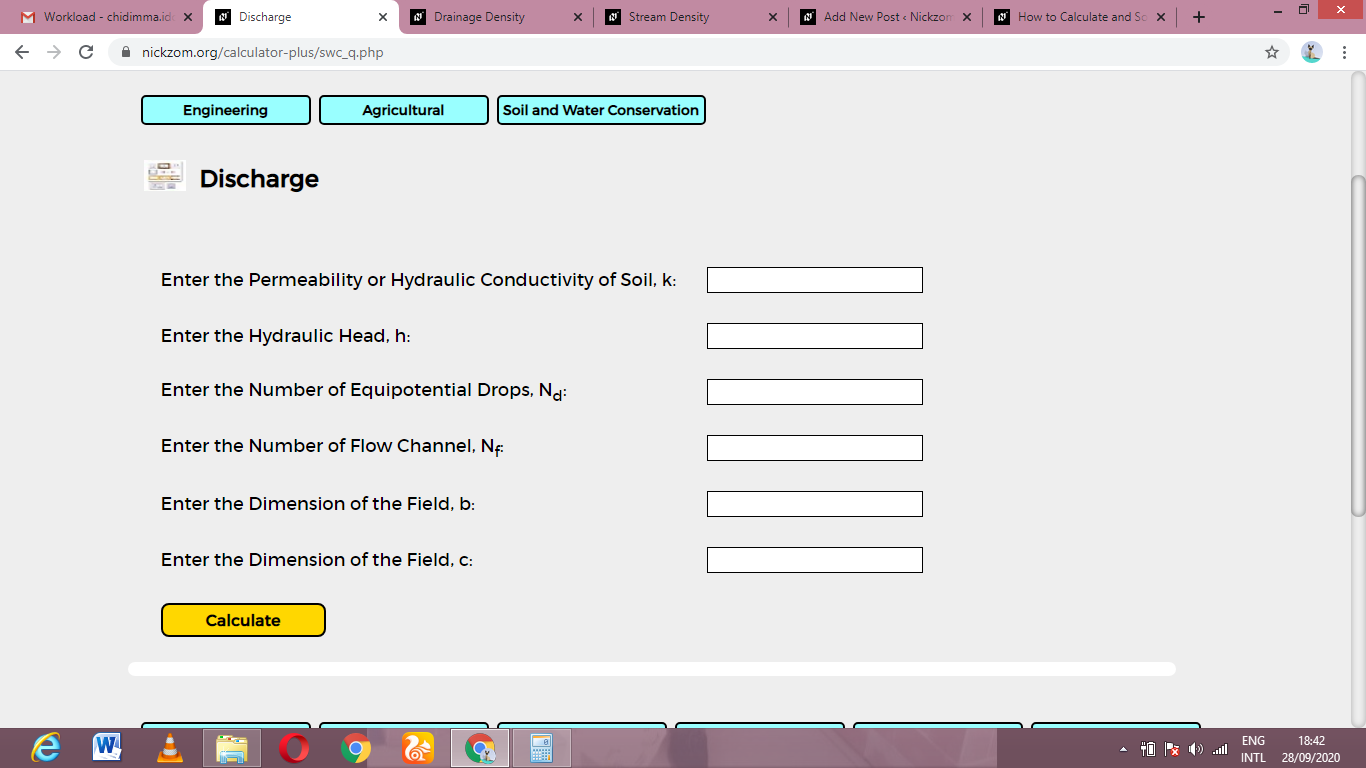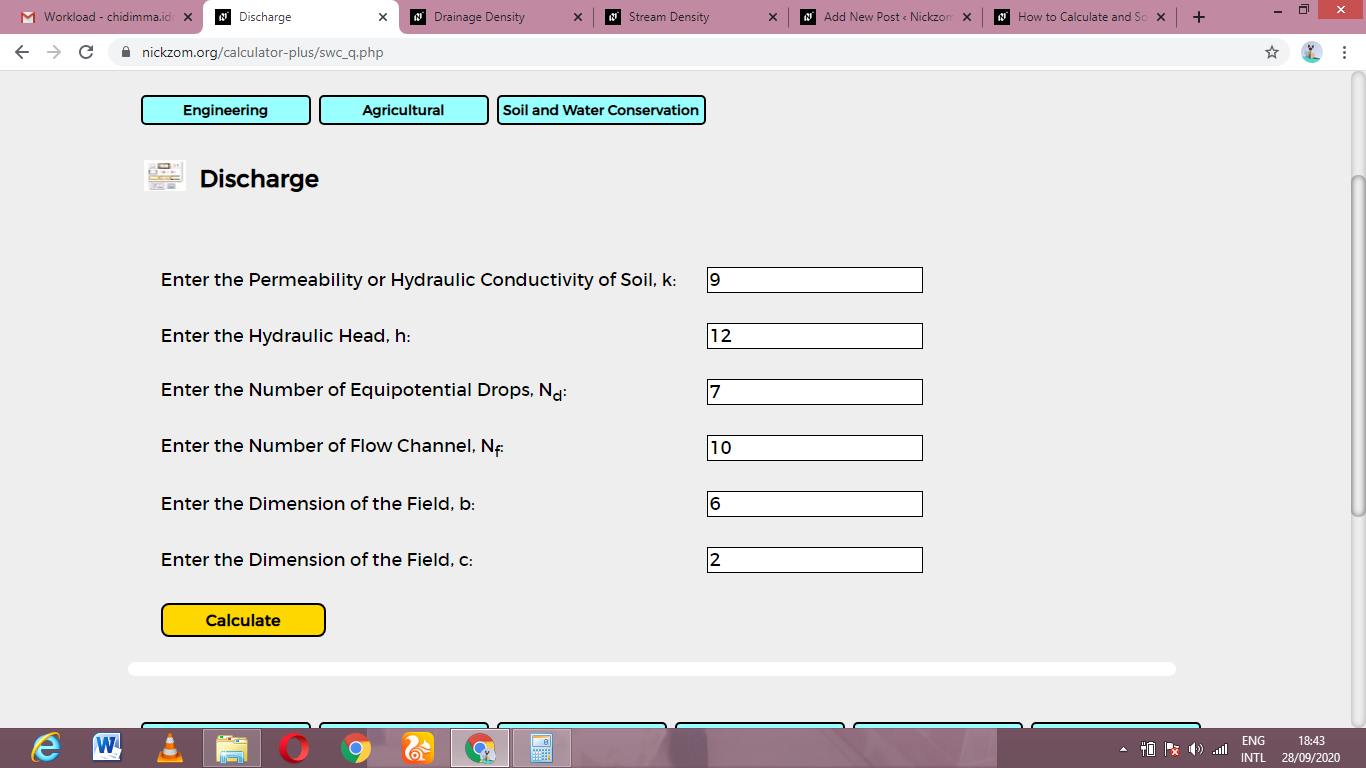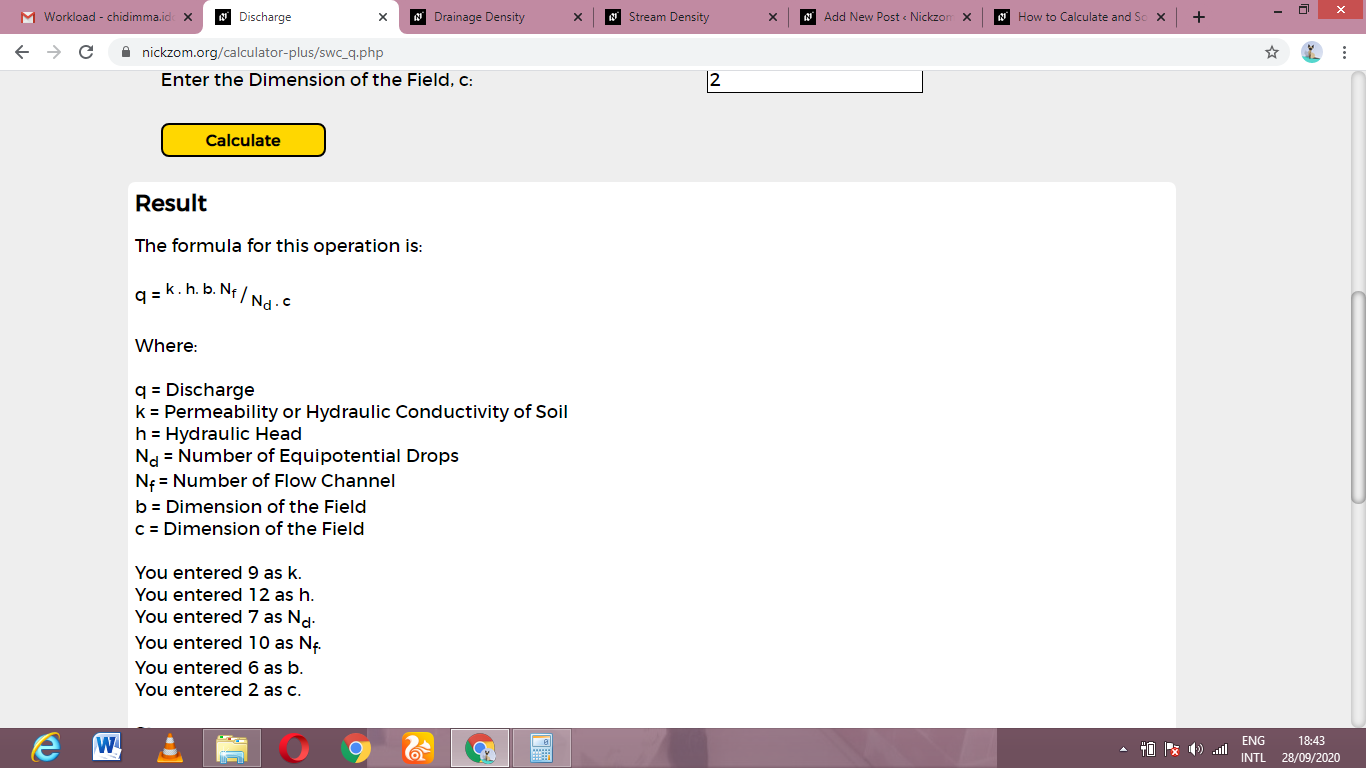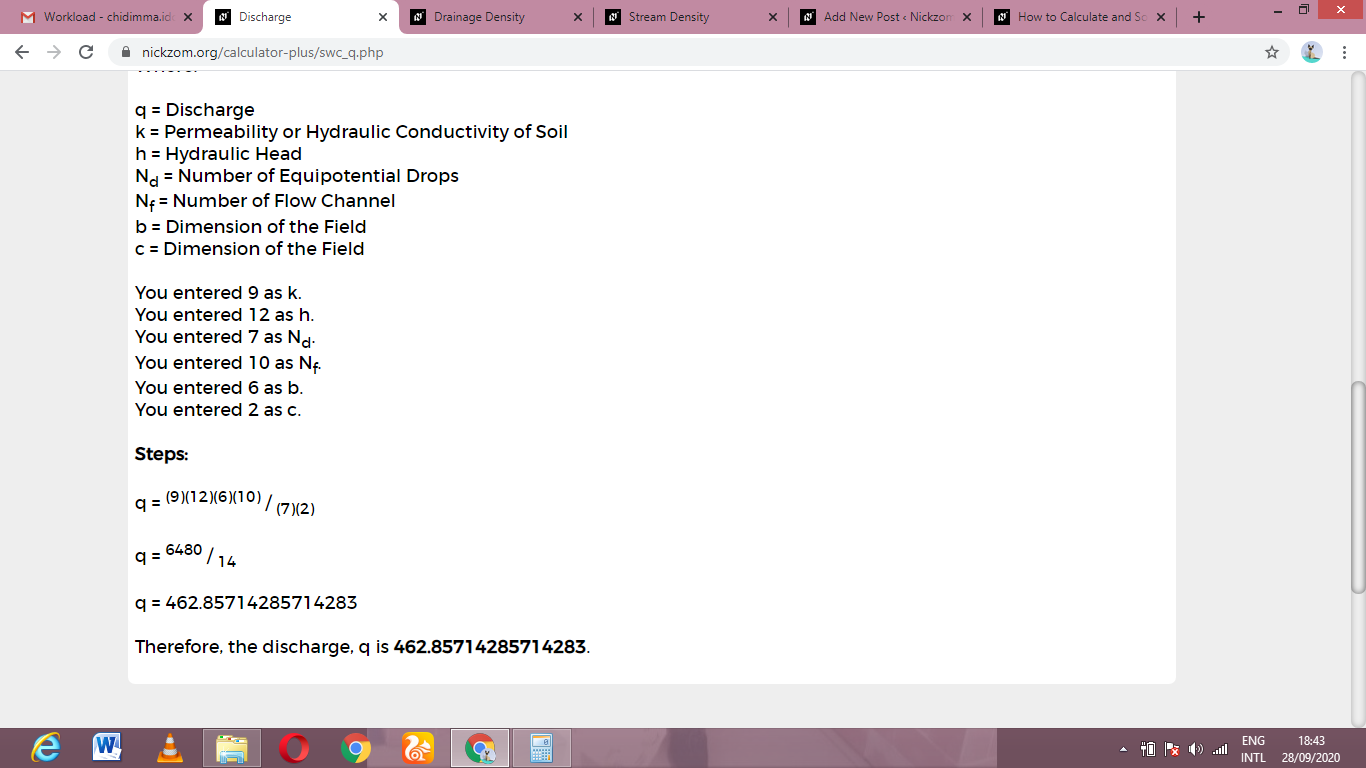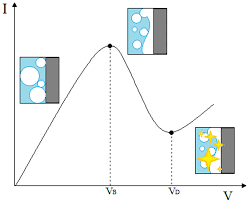
The image above represents discharge. To calculate discharge, six essential parameters are needed and these parameters are Permeability or Hydraulic conductivity of soil (k), Hydraulic head (h), Number of equipotential drops (Nd), Number of flow channel (Nf), Dimension of the field (b) and Dimension of the field (c).
The formula for calculating discharge;
q = k . h. b. Nf / Nd . c
Where:
q = Discharge
k = Permeability or Hydraulic Conductivity of Soil
h = Hydraulic Head
Nd = Number of Equipotential Drops
Nf = Number of Flow Channel
b = Dimension of the Field
c = Dimension of the Field
Let’s solve an example;
Find the discharge when the permeability or hydraulic conductivity of soil is 9, the hydraulic head is 12, the number of equipotential drops is 7, the number of flow channel is 10, the dimension of the field is 6 and the dimension of the field is 2.
This implies that;
k = Permeability or Hydraulic Conductivity of Soil = 9
h = Hydraulic Head = 12
Nd = Number of Equipotential Drops = 7
Nf = Number of Flow Channel = 10
b = Dimension of the Field = 6
c = Dimension of the Field = 2
q = k . h. b. Nf / Nd . c
Then, q = (9)(12)(6)(10) / (7)(2)
q = 6480 / 14
q = 462.8
Therefore, the discharge is 462.8.
Calculating for Permeability or Hydraulic Conductivity of soil when the Discharge, the Hydraulic Head, the Number of Equipotential Drops, the Number of Flow Channel, the Dimension of the Field and the Dimension of the Field are Given
k = q x (Nd.c) / h.b.Nf
Where;
k = Permeability or Hydraulic Conductivity of Soil
q = Discharge
h = Hydraulic Head
Nd = Number of Equipotential Drops
Nf = Number of Flow Channel
b = Dimension of the Field
c = Dimension of the Field
Let’s solve an example;
Find the permeability or hydraulic conductivity of soil when the discharge is 10, the hydraulic head is 7, the number of equipotential drops is 5, the number of flow channel is 4, the dimension of the field is 12 and the dimension of the field is 6.
This implies that;
q = Discharge = 10
h = Hydraulic Head = 7
Nd = Number of Equipotential Drops = 5
Nf = Number of Flow Channel = 4
b = Dimension of the Field = 12
c = Dimension of the Field = 6
k = q x (Nd.c) / h.b.Nf
That is, k = 10 x (5)(6) / 7.12.4
k = 30 / 336
k = 0.089
Therefore, the permeability or hydraulic conductivity of soil is 0.089.
Read more: How to Calculate and Solve for Drainage Density | Soil and Water Conservation
Calculating for Hydraulic Head when the Discharge, the Permeability or Hydraulic Conductivity of soil, the Number of Equipotential Drops, the Number of Flow Channel, the Dimension of the Field and the Dimension of the Field are Given
h = q x (Nd.c) / k.b.Nf
Where;
h = Hydraulic Head
q = Discharge
k = Permeability or Hydraulic Conductivity of Soil
Nd = Number of Equipotential Drops
Nf = Number of Flow Channel
b = Dimension of the Field
c = Dimension of the Field
Let’s solve an example;
Find the hydraulic head when the discharge is 21, the permeability or hydraulic conductivity of soil is 14, the number of equipotential drops is 9, the number of flow channel is 3, the dimension of the field is 2 and the dimension of the field is 4.
This implies that;
q = Discharge = 21
k = Permeability or Hydraulic Conductivity of Soil = 14
Nd = Number of Equipotential Drops = 9
Nf = Number of Flow Channel = 3
b = Dimension of the Field = 2
c = Dimension of the Field = 4
h = q x (Nd.c) / k.b.Nf
h = 21 x (9)(4) / 14.2.3
So, h = 21 x 36 / 84
h = 756 / 84
h = 9
Therefore, the hydraulic head is 9.
Calculating for Number of Equipotential Drops when the Discharge, the Permeability or Hydraulic Conductivity of soil, the Hydraulic Head, the Number of Flow Channel, the Dimension of the Field and the Dimension of the Field are Given
Nd = k.b.Nf / q x c
Where;
Master Calculations Instantly
Unlock solutions for math, physics, engineering, and chemistry problem with step-by-step clarity. No internet required. Just knowledge at your fingertips, anytime, anywhere.
Nd = Number of Equipotential Drops
q = Discharge
k = Permeability or Hydraulic Conductivity of Soil
h = Hydraulic Head
Nf = Number of Flow Channel
b = Dimension of the Field
c = Dimension of the Field
Let’s solve an example;
Find the number of equipotential drops when the discharge is 24, the permeability or hydraulic conductivity of soil is 12, the hydraulic head is 7, the number of flow channel is 5, dimension of the field is 6 and the dimension of the field is 3.
This implies that;
q = Discharge = 24
k = Permeability or Hydraulic Conductivity of Soil = 12
h = Hydraulic Head = 7
Nf = Number of Flow Channel = 5
b = Dimension of the Field = 6
c = Dimension of the Field = 3
Nd = k.b.Nf / q x c
So, Nd = 12.6.5 / 24 x 3
Nd = 360 / 72
Nd = 5
Therefore, the number of equipotential drops is 5.
Read more: How to calculate for Tractive Force | Soil Mechanics and Foundation
Calculating for Number of Flow Channel when the Discharge, the Permeability or Hydraulic Conductivity of soil, the Hydraulic Head, the Number of Equipotential Drops, the Dimension of the Field and the Dimension of the Field are Given
Nf = q x (Nd.c) / k.h.b
Where;
Nf = Number of Flow Channel
q = Discharge
k = Permeability or Hydraulic Conductivity of Soil
h = Hydraulic Head
Nd = Number of Equipotential Drops
b = Dimension of the Field
c = Dimension of the Field
Let’s solve an example;
Find the number of flow channel when the discharge is 11, the permeability or hydraulic conductivity of soil is 10, the hydraulic head is 20, the number of equipotential drops is 6, the dimension of the field is 4 and the dimension of the field is 8.
This implies that;
q = Discharge = 11
k = Permeability or Hydraulic Conductivity of Soil = 10
h = Hydraulic Head = 20
Nd = Number of Equipotential Drops = 6
b = Dimension of the Field = 4
c = Dimension of the Field = 8
Nf = q x (Nd.c) / k.h.b
That is, Nf = 11 x (6)(8) / 10.20.4
Nf = 528 / 800
Nf = 0.66
Therefore, the number of flow channel is 0.66.
Calculating for Dimension of the Field when the Discharge, the Permeability or Hydraulic Conductivity of soil, the Hydraulic Head, the Number of Equipotential Drops, the Number of Flow Channel and the Dimension of the Field are Given
b = q x (Nd.c) / k.h.Nf
Where;
b = Dimension of the Field
q = Discharge
k = Permeability or Hydraulic Conductivity of Soil
h = Hydraulic Head
Nd = Number of Equipotential Drops
Nf = Number of Flow Channel
c = Dimension of the Field
Let’s solve an example;
Find the dimension of the field when the discharge is 10, the permeability or hydraulic conductivity of soil is 8, the hydraulic head is 4, the number of equipotential drops is 2, the number of flow channel is 9 and the dimension of the field is 3.
This implies that;
q = Discharge = 10
k = Permeability or Hydraulic Conductivity of Soil = 8
h = Hydraulic Head = 4
Nd = Number of Equipotential Drops = 2
Nf = Number of Flow Channel = 9
c = Dimension of the Field = 3
b = q x (Nd.c) / k.h.Nf
So, b = 10 x (2)(3) / 8.4.9
b = 60 / 288
b = 0.208
Therefore, the dimension of the field is 0.208.
Calculating for Dimension of the Field when the Discharge, the Permeability or Hydraulic Conductivity of soil, the Hydraulic Head, the Number of Equipotential Drops, the Number of Flow Channel and the Dimension of the Field are Given
c = k.b.Nf / q x Nd
Where;
c = Dimension of the Field
q = Discharge
k = Permeability or Hydraulic Conductivity of Soil
h = Hydraulic Head
Nd = Number of Equipotential Drops
Nf = Number of Flow Channel
b = Dimension of the Field
Let’s solve an example;
Find the dimension of the field when the discharge is 28, the permeability or hydraulic conductivity of soil is 18, the hydraulic head is 15, the number of equipotential drops is 4, the number of flow channel is 2 and the dimension of the field is 1.
This implies that;
q = Discharge = 28
k = Permeability or Hydraulic Conductivity of Soil = 18
h = Hydraulic Head = 15
Nd = Number of Equipotential Drops = 4
Nf = Number of Flow Channel = 2
b = Dimension of the Field = 1
c = k.b.Nf / q x Nd
Then, c = 18.1.2 / 28 x 4
c = 36 / 112
c = 0.321
Master Calculations Instantly
Unlock solutions for math, physics, engineering, and chemistry problem with step-by-step clarity. No internet required. Just knowledge at your fingertips, anytime, anywhere.
Therefore, the dimension of the field is 0.321.
Read more: How to Calculate and Solve for Stream Density | Soil and Water Conservation
How to Calculate Discharge in Soil and Water Conservation Using Nickzom Calculator
Nickzom Calculator – The Calculator Encyclopedia is capable of calculating the discharge.
To get the answer and workings of the discharge using the Nickzom Calculator – The Calculator Encyclopedia. First, you need to obtain the app.
You can get this app via any of these means:
Web – https://www.nickzom.org/calculator-plus
To get access to the professional version via web, you need to register and subscribe for NGN 2,000 per annum to have utter access to all functionalities.
You can also try the demo version via https://www.nickzom.org/calculator
Android (Paid) – https://play.google.com/store/apps/details?id=org.nickzom.nickzomcalculator
Android (Free) – https://play.google.com/store/apps/details?id=com.nickzom.nickzomcalculator
Apple (Paid) – https://itunes.apple.com/us/app/nickzom-calculator/id1331162702?mt=8
Once, you have obtained the calculator encyclopedia app, proceed to the Calculator Map, then click on Agricultural under Engineering.
Now, Click on Soil and Water Conservation under Agricultural
Now, Click on Discharge under Soil and Water Conservation
The screenshot below displays the page or activity to enter your values, to get the answer for the discharge according to the respective parameters which is the Permeability or Hydraulic conductivity of soil (k), Hydraulic head (h), Number of equipotential drops (Nd), Number of flow channel (Nf), Dimension of the field (b) and Dimension of the field (c).
Now, enter the values appropriately and accordingly for the parameters as required by the Permeability or Hydraulic conductivity of soil (k) is 9, Hydraulic head (h) is 12, Number of equipotential drops (Nd) is 7, Number of flow channel (Nf) is 10, Dimension of the field (b) is 6 and Dimension of the field (c) is 2.
Finally, Click on Calculate
As you can see from the screenshot above, Nickzom Calculator– The Calculator Encyclopedia solves for the discharge and presents the formula, workings and steps too.
